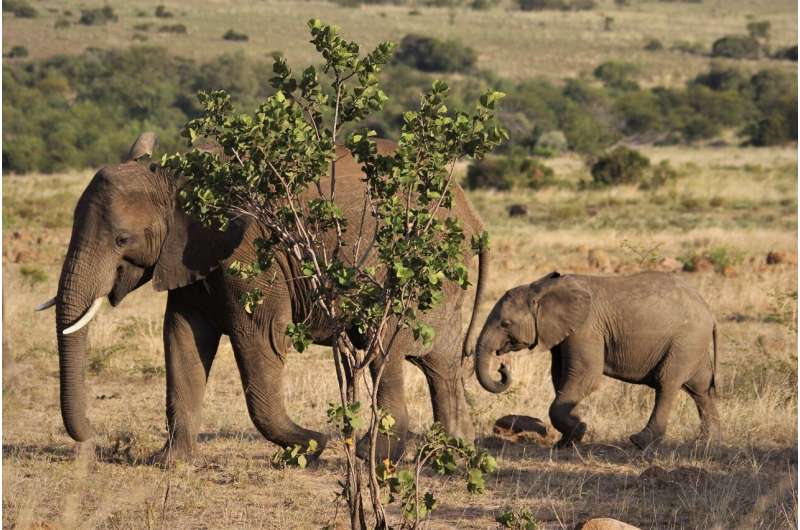This article has been reviewed according to Science X's editorial process and policies. Editors have highlighted the following attributes while ensuring the content's credibility:
fact-checked
trusted source
proofread
Developing diagnostics for a deadly elephant disease

This past summer, staff at the Louisville Zoo noticed their three-year-old African elephant, Fitz, was less active than usual. A blood test confirmed that he had elephant endotheliotropic herpesvirus (EEHV), which can cause a deadly hemorrhagic disease. The staff in Louisville and at zoos around the country rushed to help, but despite antiviral medications, plasma transfusions, and other supportive therapies, Fitz died only a few days later.
EEHV is the leading cause of death in Asian elephant calves living under managed care and is known to affect free-ranging populations and African elephants as well. Once a young elephant begins to show symptoms of hemorrhagic disease—such as lethargy or disinterest in food—it is usually too late to help them. Marjorie Bercier, D.V.M., DACZM, an assistant professor at Cummings School of Veterinary Medicine at Tufts University, is investigating a blood test that would detect the early progression of hemorrhagic disease in elephants, to help care teams make treatment decisions sooner.
"If we start treating them earlier in the disease process, before we start to see clinical signs, it increases their chance of survival," Bercier said. "I'm looking for a diagnostic test that would help us know how critical the elephant is while the virus is present in their blood."
Once an elephant has EEHV, it will be a carrier for life. Adult elephants are not generally affected by it, but they will shed the virus intermittently throughout their life. It's likely that calves will be exposed to these viruses—there are multiple herpesvirus strains—through contact with the herd. Mothers seem to pass some protection on to nursing calves, but this protection is temporary. After some time, elephant calves become vulnerable to the virus for the first eight-or-so years of their life.
"It's this Sword of Damocles that's over their head for all of their juvenile years because even if they recover from one herpesvirus, they could still be exposed to a different one," Bercier said. "It's an extremely challenging condition to manage, monitor, and treat."
Currently, most zoological institutions test their young elephants for EEHV weekly, monitoring for viral levels in their blood. But rising viral levels don't always turn into hemorrhagic disease, Bercier said. Sometimes the virus will be active for a while and then simply return to being dormant without ever causing symptoms. This makes it difficult to determine when to begin intensive treatment. Instead of looking at viral levels, Bercier is looking for evidence of hemorrhagic disease using a D-dimer test, which detects remnants of dissolved blood clots.
The hemorrhagic disease caused by EEHV first appears as lesions on blood vessel walls. Clots form over these lesions and eventually break down, producing D-dimer proteins as a byproduct. As the disease progresses, the number of lesions outpaces the body's ability to clot, and the animal begins to hemorrhage and rapidly decline. Bercier is trying to determine if the level of D-dimer in an elephant's blood can tell us whether an animal is going to develop a serious case.
"I'm hoping that D-dimers could be used as a tool to differentiate between cases that will eventually be at risk of dying from hemorrhagic disease and those that won't, to help zoo and wildlife vets determine when they should ring the alarm and start intensive treatment," Bercier said.
Bercier got the funding for her first pilot study from the Tufts Elephant Conservation Alliance, a multi-disciplinary group of faculty members that is dedicated to connecting the spirit of the university's beloved mascot to tangible elephant conservation efforts—Jumbos for Jumbos, as they describe it. She now has support from the Wild Animal Health Fund and the International Elephant Foundation as well.
Bercier's preliminary results show that the test holds promise, but she needs more data to confirm her findings and determine what D-dimer levels should prompt treatment. She is reaching out to colleagues at zoological institutions around the world for additional samples and collaborations.
"The more information we can gather about this condition, the better it's going to be for all elephants," Bercier said. "What we learn from captive elephants is going to help the global population of both species—Asian and African elephants—under managed care and in the wild, because all of them are at risk."
Provided by Tufts University



















